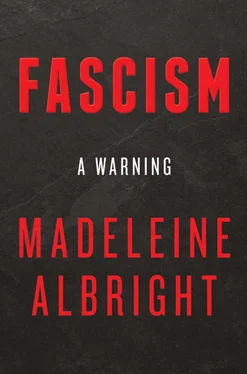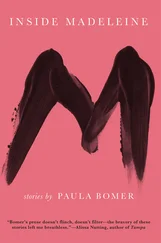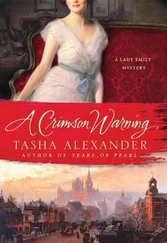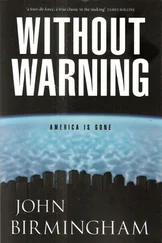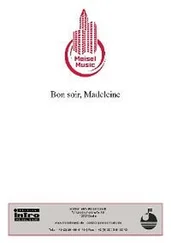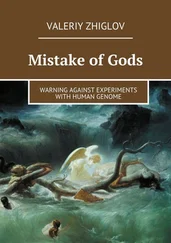The abdication of Kaiser Wilhelm II led to the installation of multiparty democracy at an inauspicious time. The new Weimar Republic confronted a spiteful Europe, an indifferent America, and a wounded citizenry. As the government, it could not avoid responsibility for the harsh terms of the Versailles Treaty, which dictated that Germany accept blame for the war, disarm, cede territory, and pay reparations. The republic’s leaders were held accountable, as well, for the hyperinflation that soon followed, wiping out the life savings of many in the middle class. As in Italy, the conflict’s end prompted agitation on the part of labor unions, with frequent strikes and protests, while millions of soldiers returned from the front, scarred in body and mind, scrounging for jobs that weren’t there. Feelings of alienation were amplified by the sense Germans had developed of themselves during the nineteenth century as the custodians of a nation apart, with a divine mission and a unique cultural heritage. They were winners, were they not?—but now they felt lost.
In the fall of 1919, Hitler joined the Bavaria-based German Workers’ Party, a group of rabble-rousing nationalists so small that it had immediate room for him within its leadership. Though in truth the fifty-fifth member, he was designated “party comrade 555,” to give the appearance of larger numbers. Put in charge of propaganda, Hitler began holding public meetings and sought to attract new members through a platform demanding the abrogation of the Versailles Treaty, the unification of all Germans, the exclusion of Jews from citizenship, and share-the-wealth measures directed at the rich. To seduce the left, the movement changed its name to “National Socialist German Workers Party”—or Nazis.
Early on, Hitler forged an alliance with army captain Ernst Röhm, who began to steer veterans toward the new party. Röhm organized his recruits into a militia, the Sturmabteilung, with the mission of beating up Communists; he also stole money from the army to finance a newspaper. The party’s biggest asset, however, was the man its members referred to as “the drummer,” its public voice.
Now in his early thirties, Hitler was an undisciplined but mesmerizing orator. The Iron Cross he had earned while in the military steeled his nerve, and his time on the streets gave him an intuitive sense of what delighted audiences—and it wasn’t abstract theories or objective arguments. He used simple words and did not hesitate to tell what he later described as “colossal untruths.” He sought to incite hatred toward those he considered traitors—the “November criminals” whose treachery had cost Germany the war—and he returned each day to what Nietzsche had called the ideology “of those who feel cheated”: anti-Semitism.
Speaking in town squares, beer halls, and circus tents, Hitler employed over and over again the same action verbs— smash, destroy, annihilate, kill. In a typical address, he would shout himself into a lather of arm-flailing, screaming fury at the nation’s enemies, only to grow abruptly calm as he painted a word picture of what a new era of German ascendance might look like. Gradually, party membership expanded and so did the show-business aspects. The Nazis adopted a stiff-armed salute and—in another bow to Mussolini—started wearing brown shirts. They organized rallies, at which Röhm’s swelling cadre of thugs conveyed an aura of menace. Hitler designed a flag in the colors of the old German Republic. “We National Socialists,” he wrote, “regarded our flag as being the embodiment of our party programme. The red expressed the social thought underlying the movement. White the national thought. And the swastika signified the mission allotted to us—the struggle for the victory of Aryan mankind.” These efforts paid off; the Nazi Party was establishing a presence, but—amid the chaos of the early 1920s—few were paying close attention.
In November 1923, Hitler’s impatience got the better of his judgment and he tried to replicate Mussolini’s already legendary March on Rome. It was a harebrained scheme. The Nazis hoped to spark a nationwide coup by seizing control of Bavaria, but to prevail, they needed the army’s support, which they didn’t get. The ringleaders were arrested and the coup went nowhere. Of the conspirators, Hitler alone was brazen enough to admit that he had intended to overthrow the government. In his first appearance on the national stage, he made the case for an uprising that would cleanse all Germany, then told the court that he had no choice but to perform his duty as “a man born to be a dictator.” Given a five-year sentence, he was released on probation after thirteen months, having made productive use of his time. The manuscript tucked under Hitler’s arm as he exited the prison bore the title Four and a Half Years of Struggle Against Lies, Stupidity, and Cowardice , later shortened by his publisher to volume one of My Struggle —or Mein Kampf .
The failed putsch left Hitler doubly resolute but newly cautious; he decided to pursue power through what he called a “policy of legality.” This approach didn’t rule out the use of violence, but it did demand something more: a nationwide political organization. The Nazis set to work broadening their base. By 1929 they had daily and weekly newspapers and special clubs for young people, women, teachers, lawyers, and doctors. To whip up enthusiasm, Hitler continued to decry the government’s payment of war reparations, an act that was, to his mind, a craven admission of national guilt. He denounced the British and French for plotting to keep Germany poor and weak. He lambasted mainstream politicians for ignoring the needs of the common people. Above all, he heaped scorn on the Communists, a strategy that won him friends in the financial community and favorable coverage in some of the nation’s largest media outlets.
Still, as the twenties stumbled to their tumultuous end, the Nazis remained a minor party and at the mercy of events. For them, good news was bad news. The economy had begun to perk up. Inflation was tamed. Hitler’s countrymen were feeling better about the future and therefore less interested in the supposed cure-all he had to sell.
Then, suddenly, the Great Depression blocked the road to recovery and Germany went into a tailspin. With excess capital earmarked for war reparations, the nation’s investments had been financed entirely by borrowing. Now debts had to be repaid and credit was no longer available. Global markets shrank, squeezing the demand for exports. Production declined, unemployment quadrupled, and businesses shut their doors while pawnshops opened theirs. Leaders of the traditional political parties did little but squabble, creating a deadlock in the Reichstag, followed by a series of elections that settled nothing. An angry man for an angry age, the future Führer had found his audience at last. With Deutschland once more on its knees, he offered himself as a bullhorn for its misery. He lashed out again at the November criminals and argued that the time had come for a new generation of fearless Germans led by a party that would fulfill the fatherland’s destiny, lift the people up, and crush their foes.
In September 1930, unhappy voters marched to the polls with protest on their minds. The Nazi tally went up, and the party’s position in the Reichstag improved as Hitler scored impressive gains among women, small businesspeople, peasants, and the young. Overnight, what had been the ninth-largest party became the second, trailing only the Social Democrats. Communists, too, did well as the political extremes assaulted the bastions of democracy from both sides, shrinking the center to an island whose sole inhabitants were pious aristocrats and bewildered liberals.
Читать дальше
Конец ознакомительного отрывка
Купить книгу
